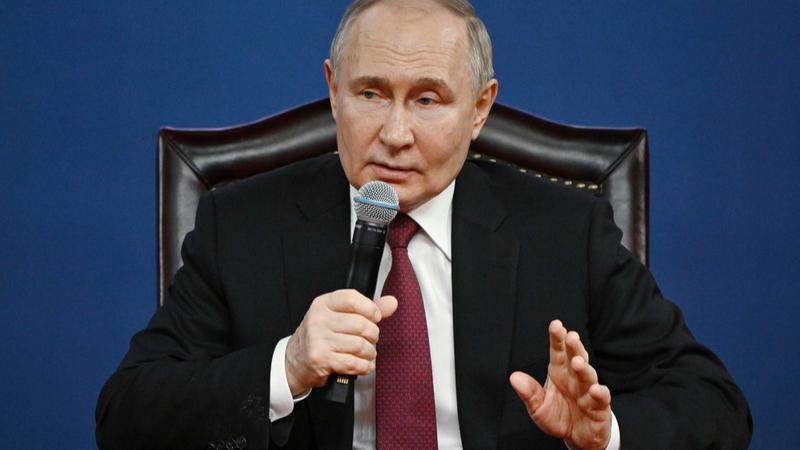Published 17:27 IST, May 17th 2024
Putin Claims Russia Plans to Establish a Buffer Zone in Kharkiv But Has No Plans to Capture the City
Putin has claimed that the recent Russian offensive in Kharkiv is a response to Ukrainian attacks on the Belgorod region.

Kyiv: Russian President Vladimir Putin said Friday that Moscow’s offensive in Ukraine’s northeastern Kharkiv region aims to create a buffer zone but has no plans to capture the city. Putin’s comments on a trip to China were his first on the offensive launched on May 10, which opened a new front in the war and displaced thousands of Ukrainians within a few days.
It came hours after a massive Ukrainian drone attack on Russian-occupied Crimea early Friday caused power cutoffs in the city of Sevastopol while damaging aircraft and fuel storage at an airbase. In southern Russia, Russian authorities said the attack also set a refinery ablaze.
Speaking to reporters Friday on a visit to Harbin, China, Putin said that Moscow launched attacks in the Kharkiv region in response to the Ukrainian shelling of Russia’s Belgorod region.
“I have said publicly that if it continues we will be forced to create a security zone, a sanitary zone,” he said.
Putin said that Russian troops were “advancing daily according to plan" and said that there were no plans to capture Kharkiv, for now.
Ukrainian troops were fighting Friday to halt Russian advances in the Kharkiv region that began late last week.
The town of Vovchansk, located just five kilometres (three miles) from the Russian border, has been a hot spot in the fighting in recent days. Ukrainian authorities have evacuated some 8,000 civilians from the town. The Russian army’s usual tactic is to reduce towns and villages to ruins with aerial strikes before its units move in.
By starting a new offensive in the north of the Kharkiv region on May 10, Russian troops “expanded the zone of active hostilities by almost 70 kilometres,” in an effort to force Ukraine to spread its forces and use the reserve troops, Ukraine’s military chief Oleksandr Syrskyi said Friday.
Meanwhile, the drone raids on Crimea marked Kyiv's attempt to strike back during Moscow's offensive in northeastern Ukraine, which has added to the pressure on outnumbered and outgunned Ukrainian forces who are waiting for delayed deliveries of crucial weapons and ammunition from Western partners.
A Ukrainian intelligence official confirmed to The Associated Press that Ukraine’s Security Service and Military Intelligence conducted a joint operation to strike Russia’s military infrastructure sites in Novorossiysk, on the Black Sea coast, and occupied Sevastopol. The official spoke on condition of anonymity because they were not authorised to comment publicly.
The operation targeted ships and vessels of the Russian Black Sea Fleet and was conducted by aerial drones built in Ukraine, the official said.
At least three fighter jets were destroyed, according to satellite imagery of the airbase provided by Maxar Technologies.
The Russian Defense Ministry said air defences downed 51 Ukrainian drones over Crimea, another 44 over the Krasnodar region of Russia and six over the Belgorod region. It said Russian warplanes and patrol boats also destroyed six sea drones in the Black Sea.
Mikhail Razvozhayev, the governor of Sevastopol, which is the main base for Russia's Black Sea Fleet, said the drone attack damaged the city’s power plant. He said it could take a day to fully restore energy supplies and warned residents that power would be cut to parts of the city.
“Communal services are doing their best to restore the power system as quickly as possible,” he said in a statement.
Razvozhayev also announced that schools in the city would be closed temporarily.
Earlier Ukrainian attacks damaged aircraft and a fuel storage facility at Belbek air base near Sevastopol, according to satellite images released by Maxar Technologies.
In the Krasnodar region, the authorities said a drone attack early Friday caused a fire at an oil refinery in Tuapse which was later contained. There were no casualties.
Ukraine has repeatedly targeted refineries and other energy facilities deep inside Russia, causing significant damage.
The Krasnodar region’s governor, Veniamin Kondratyev, said fragments of downed drones around the port of Novorossiysk caused several fires but there were no casualties.
Belgorov Governor Vyacheslav Gladkov said a Ukrainian drone struck a vehicle, killing a woman and her four-year-old child. Another attack set a fuel tank ablaze at a gas station in the region, he said.
In addition to Kharkiv, recent Russian offensive attacks have come in the eastern Donetsk region, as well as the Chernihiv and Sumy regions in the north and in the southern Zaporizhzhia region. The apparent aim is to stretch depleted Ukrainian resources and exploit weaknesses.
According to Syrskyi, the Ukrainian military commander, having strengthened their grouping in the northern region, Russian forces are now concentrating their efforts on advancing near the village of Lyptsi, as well as the town of Vovchansk.
Syrskyi also said he inspected the units that are “preparing for defence” of the Sumy region. On Tuesday, the head of Ukraine’s Military Intelligence, Kyrylo Budanov, reportedly said that the Russian army had plans to start offensive actions in Sumy.
Russia has also been testing defences at other points along the roughly 1,000-kilometre (620-mile) front line snaking from north to south through eastern Ukraine. That line has barely changed over the past 18 months in what has become a war of attrition.
Updated 17:27 IST, May 17th 2024




